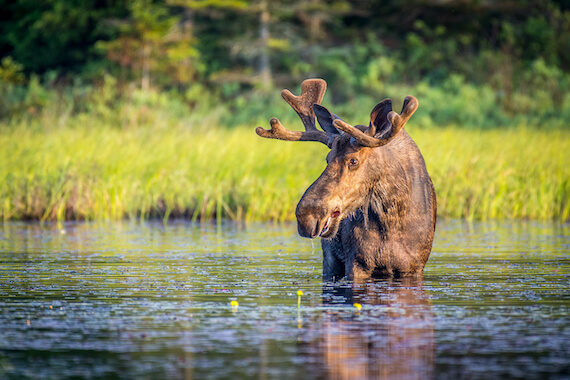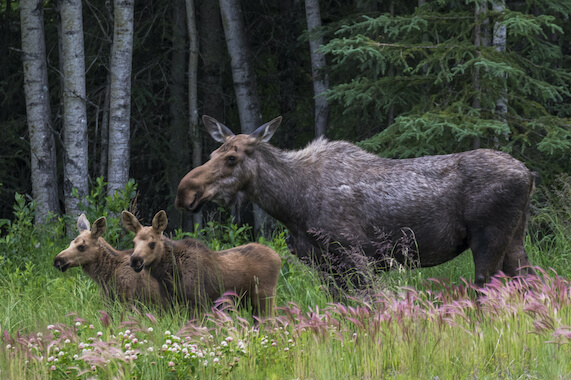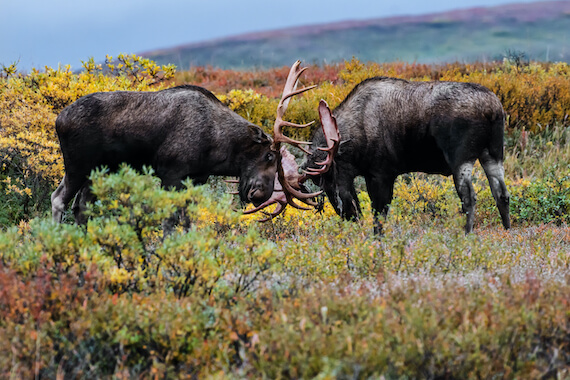
| Kingdom | Animalia |
| Phylum | Chordata |
| Class | Mammalia |
| Order | Artiodactyla |
| Family | Cervidae |
| Subfamily | Capreolinae |
| Genus | Alces |
| Species | Alces alces |
| Niche | Herbivorous browsing deer |
| Height | 4.6 – 6.9 ft (1.4 – 2.1 m) at the shoulder |
| Antler Span | 3.9 – 6.9 ft (1.2 – 2.1 m) |
| Weight | 838 – 1808 lb (380 – 820 kg) |
| Lifespan | 15 – 25 years |
| Social Structure | Solitary |
| Conservation Status | Least Concern |
| Preferred Habitat | Boreal forests with lakes or streams |
| Average Number of Offspring | 1 |
| Main Food Item | Tree shoots, leaves, bark & aquatic plants |
| Predators | Siberian tigers, wolves, bears, humans |
The Basics
The moose is a species of deer native to boreal forests across Canada, the United States, Scandinavia, Eastern Europe and Russia. It is the largest living species in the deer family. Male adult moose, or bulls, are characterized by their broad and flat palmate antlers, which differ to the twig-like dendritic antlers of most members of the deer family. Bulls shed their antlers each autumn after the mating season and grow a new pair the following spring in preparation for mating once again.
There are 9 recognized subspecies of moose, which each exhibit different distributions and physical features such as size, pelage colour and antler morphology. The largest subspecies in North America is the Alaskan moose, whilst the smallest subspecies is the Shiras’ moose, also known as the Yellowstone moose. In general, moose are larger at higher latitudes where it is colder and are smaller at lower latitudes where it is warmer.
Moose are well-adapted to living in cold climates thanks to their thick skin and double-layered fur, which consists of a soft woolly undercoat plus a top layer of long guard hairs. These guard hairs are hollow and trap air inside, thus providing extra insulation. The large size of moose also means they have a low surface area to volume ratio, which is another adaptation to reduce heat loss.
Whilst moose thrive in their cold boreal habitat as a result of these adaptations, they are not particularly tolerant of warm weather. In order to cool themselves down in the summer months, moose seek out shade or cool breezes and immerse themselves in the cold waters of lakes or ponds. Heat stress caused by high temperatures reduces the foraging activity of moose, leading to reduced weight, which in turn increases the risk of disease and hypothermia in winter, as well as causing a decline in pregnancy rates.

Behavior and Ecology
Moose are browsing herbivores and feed on a wide variety of plants and fruits. Unlike grazers, these animals prefer non-grasses and tend to eat the leaves, soft shoots and fruits of high-growing woody plants. Although moose are generalists, they show a preference for the new growths of deciduous trees with a high sugar content including white birch, aspen and willow. Moose also commonly feed on aquatic plants including lilies and pondweed.
Moose are solitary animals and rarely gather in groups outside of the mating season, which occurs in September and October. During this time, which is known as the rut, mature bulls stop feeding completely for two weeks, perhaps as a byproduct of hormonal changes related to scent-urinating or other rutting behaviors. Bulls are polygamous, so seek to mate with several females, or cows, during a single mating season, which creates competition between males for access to females. When this occurs, two males assess each other’s dominance based on their antlers and body size and one may retreat. However, these encounters can escalate into physical fights using their antlers if neither retreats.
Cows usually give birth to a single calf weighing around 30 pounds (13.6 kg) following an eight-month gestation period. However, twins can occur if food is plentiful and the prevalence of twins in populations with good nutrition can be as high as 40%. Newborn moose have brown fur like their parents but with a red tint, which fades away as they mature. Calves develop quickly and are able to outrun a human at only 5 days old. They stay with their mothers for around one year until the next mating season, at which point they leave to begin their solitary lifestyle.

Moose have a number of natural predators, which differ across their extensive range. For example, the Siberian tiger regularly preys on adult moose in the Russian Far East. In North America and Eurasia, both gray wolf packs and brown bears pose a threat to adults, particularly to cows with calves. Amercian black bears and cougars also prey on newborn calves in May and June across North America. Furthermore, moose are sometimes hunted by killer whales when swimming between islands off North America’s northwest coast.
Fun Facts about Moose
From their huge antlers to their surprising swimming ability, moose adaptations demonstrate a number of interesting biological concepts.
Handicapped males
In the polygamous moose mating system, males seek to mate with multiple females during the rut. However, females themselves mate with very few males and as a result are choosy about who they mate with. Females prefer to mate with dominant males and use physical cues such as antler size to assess the relative dominance of different males.
Antlers are honest indicators of male health because they are both costly to produce and to carry around, thus a male with big antlers must be relatively fit and healthy in order to successfully survive despite the handicap they impose. Another example of an honest indicator of male health is the peacock’s tail, which significantly handicaps the male’s ability to fly and is also costly to produce. Thus, peacocks with long tails must be relatively healthy in order to survive with such an appendage.

Keen Swimmers
Moose are excellent swimmers despite their bulk and have been known to swim several miles at a time. They are able to stay afloat when swimming thanks in part to the air trapped inside their hollow guard hairs, which aids buoyancy. Moose are the only species of deer than can feed underwater and are capable of diving over 18 feet (5.5 meters) deep to reach plants on the bottom of lakes. In order to successfully forage in this way, moose can hold their breath underwater for 30 seconds and have evolved special fatty pads and muscles in their nose that close the nostrils when water pressure is high.
But moose are not the only land mammal that have adapted to take advantage of aquatic resources. Elephants are also accomplished swimmers and can cover distances up to 31 miles (50 km). In fact, it has even been hypothesised that the elephant’s trunk first evolved as a snorkel. Similarly, sloths and tigers are both regular swimmers, using waterways to move between islands in mangrove forests, with sloths actually moving faster in water than on land.
Dewlap
Both male and female moose have a long fold of skin under the chin called a dewlap or bell. Although the evolutionary function of this feature is unknown, it has been suggested that it might play a role in sexual selection, as is the case for lizards and birds. In these animals, males often have larger dewlaps than females and use them in their sexual displays to attract a mate. Similarly, it has been hypothesised that the dewlaps of male moose might serve as a visual or olfactory signal to females, or as a dominance signal to intimidate other males, like antlers do.
